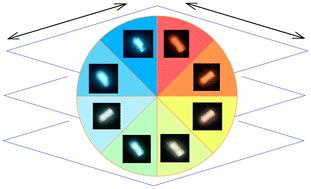当前位置:
X-MOL 学术
›
Dalton Trans.
›
论文详情
Our official English website, www.x-mol.net, welcomes your
feedback! (Note: you will need to create a separate account there.)
Solvatomorphic phase transitions and tunable luminescence emission in lanthanide metal–organic frameworks
Dalton Transactions ( IF 3.5 ) Pub Date : 2024-11-08 , DOI: 10.1039/d4dt02613f Alena A. Vasileva, Pavel A. Demakov, Tatiana Y. Guselnikova, Alexey A. Ryadun, Vladimir P. Fedin, Danil N. Dybtsev
Dalton Transactions ( IF 3.5 ) Pub Date : 2024-11-08 , DOI: 10.1039/d4dt02613f Alena A. Vasileva, Pavel A. Demakov, Tatiana Y. Guselnikova, Alexey A. Ryadun, Vladimir P. Fedin, Danil N. Dybtsev

|
Four new metal–organic frameworks with the formulae [Sm2(phen)2(NO3)2(chdc)2]·2solv, where solv = N,N-dimethylformamide (DMF; 1), N,N-dimethylacetamide (DMA; 2), N,N-diethylformamide (DEF; 3), N-formylpiperidine (NFP; 4), phen = 1,10-phenanthroline and chdc2− = trans-1,4-cyclohexanedicarboxylate were synthesized and structurally characterized. These compounds are based on similar binuclear samarium(III)-carboxylate blocks, bound by flexible chdc linkers into layered sql-type coordination networks. The amide solvents drive different intralayer block orientations between 1 and 2–4 and different layer-to-layer packings in all the described compounds. A pronounced dependence of the emission color upon the excitation wavelength variation was determined for 1–4, while the relative impacts of Sm3+ and phen emission on overall luminescence were found to depend strongly on these packings, and their reasonable correlation to the distances between the closest π–π-stacked phen moieties in the structures was revealed. Phase transitions between compounds 1–4 were studied by means of powder X-ray diffraction. Additionally, bimetallic near-white luminophores were obtained for phases 3 and 4 by doping their synthetic systems with a minor (∼5%) Tb3+ additive. In general, this study shows a possibility of tuning the luminescence properties of porous metal–organic frameworks by minor structural differences induced by solvent-driven dynamics with no apparent quenching or other direct impact on the optical properties of the included solvent.
中文翻译:

镧系金属-有机框架中的溶晶相变和可调发光发射
四种新型金属有机框架,分子式为 [Sm2(phen)2(NO3)2(chdc)2]·2solv,其中溶剂 = N,N-二甲基甲酰胺 (DMF;1)、N,N-二甲基乙酰胺 (DMA;2)、N,N-二乙基甲酰胺 (DEF;3)、N-甲酰哌啶 (NFP;4)、PHen = 1,10-菲咯啉和 CHDC2− = 反式-1,4-环己烷二羧酸盐被合成并进行了结构表征。这些化合物基于类似的双核钐 (III)-羧酸盐嵌段,通过灵活的 chdc 接头结合成分层的 sql 型配位网络。酰胺溶剂驱动 1 和 2-4 之间的不同层内嵌段取向,并在所有描述的化合物中驱动不同的层间堆积。确定了 1-4 的发射颜色对激发波长变化的显着依赖性,而发现 Sm3+ 和酚发射对整体发光的相对影响在很大程度上取决于这些堆积,并且它们与结构中最近的 π-π 堆叠酚部分之间的距离有合理的相关性被揭示。通过粉末 X 射线衍射研究化合物 1-4 之间的相变。此外,通过掺杂其合成体系,在第 3 阶段和第 4 阶段获得双金属近白色发光团 (∼5%) Tb3+ 添加剂。 一般来说,这项研究表明,通过溶剂驱动动力学引起的微小结构差异,可以调整多孔金属-有机框架的发光特性,而没有明显的猝灭或其他对所含溶剂的光学特性的直接影响。
更新日期:2024-11-08
中文翻译:

镧系金属-有机框架中的溶晶相变和可调发光发射
四种新型金属有机框架,分子式为 [Sm2(phen)2(NO3)2(chdc)2]·2solv,其中溶剂 = N,N-二甲基甲酰胺 (DMF;1)、N,N-二甲基乙酰胺 (DMA;2)、N,N-二乙基甲酰胺 (DEF;3)、N-甲酰哌啶 (NFP;4)、PHen = 1,10-菲咯啉和 CHDC2− = 反式-1,4-环己烷二羧酸盐被合成并进行了结构表征。这些化合物基于类似的双核钐 (III)-羧酸盐嵌段,通过灵活的 chdc 接头结合成分层的 sql 型配位网络。酰胺溶剂驱动 1 和 2-4 之间的不同层内嵌段取向,并在所有描述的化合物中驱动不同的层间堆积。确定了 1-4 的发射颜色对激发波长变化的显着依赖性,而发现 Sm3+ 和酚发射对整体发光的相对影响在很大程度上取决于这些堆积,并且它们与结构中最近的 π-π 堆叠酚部分之间的距离有合理的相关性被揭示。通过粉末 X 射线衍射研究化合物 1-4 之间的相变。此外,通过掺杂其合成体系,在第 3 阶段和第 4 阶段获得双金属近白色发光团 (∼5%) Tb3+ 添加剂。 一般来说,这项研究表明,通过溶剂驱动动力学引起的微小结构差异,可以调整多孔金属-有机框架的发光特性,而没有明显的猝灭或其他对所含溶剂的光学特性的直接影响。


















































 京公网安备 11010802027423号
京公网安备 11010802027423号